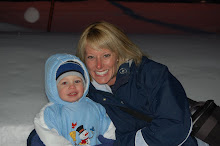I am posting the latest article from babycenter.com. I get weekly emails from them letting me know about Carson's age and what to expect. They are great emails, and I have been getting them since the beginning of my pregnancy. Anyways, Carson had been babbling a lot, and he does some of the signs they mention below - arms up to pick him up as well as pushing things away, nodding his head for yes, and reaching for things he wants. He grunts and groans to make noises for things he wants or to let you know he's frustrated when you don't know what he's saying. Man, we are by the book on this one! I just wanted to let you know that we all need to work on showing him some signs and teaching him "adult" words and not "baby" words.
Your 13-month-old's language and cognitive development: Can we talk?by Dana SullivanReviewed by the BabyCenter Medical Advisory Board
HighlightsNew this month: Can we talk?What you can doOther developments: Intonation awareness and object permanence
New this month: Can we talk?
Around 13 months, many toddlers have vocabularies that consist of three or four words. Yours can probably say "mama" or "dada," and something like "ta ta," for thank you, "ba" for bottle or ball, and "bye-bye." But don't be upset if she can't. She's still in what experts call the "passive" phase of language acquisition. That means she's soaking up all the words and speech around her, and filing the information away for later use. Even if she doesn't say any words clearly, she can probably communicate her needs with gestures (holding her arms out so you'll pick her up), sounds, and body positions, such as turning her head away from something she doesn't want.
What you can do
If you've already got a little talker on your hands, encourage her to keep trying new words by labeling as many actions and objects as you can. Use clear, simple speech, and an "adult" voice. Talk about where you're going as you strap her into her car seat. While you're at the grocery store, tell her what you're looking at ("Let's get some bananas," or "Here's the milk"). Talking to your child, even if she can't fully respond, makes her feel like she's a part of what's going on around her and makes her want to participate in the conversation. Singing songs, especially ones with gestures, such as "Itsy-Bitsy Spider," and "Wheels on the Bus," make speech fun and interesting, too — plus they introduce your child to music.The other side of talking is listening. If you want to encourage your child to talk, listen to her as she "converses" with you just as you would if you could understand every word perfectly. Keep eye contact and respond with smiles and nods, and she'll want to tell you more and more — and she'll be learning valuable lessons about listening carefully while another person is talking.Even if your 13-month-old says just a few words, she can probably communicate many more. Have you ever noticed how babies even younger than 13 months will wave good-bye, blow kisses, and nod or shake their head to say yes or no? They're talking with gestures that they've observed you using. Recent research suggests that children are capable of assigning different gestures to dozens of words — but it's up to you to teach them. If your toddler seems frustrated by her inability to make you understand her needs, try making up hand signs to help her. You might hold your thumb to your mouth to signal the word "drink," for instance. For a few days, whenever you hand her a cup, show her the gesture and say the word at the same time. Within a few days, she may surprise you by using the sign herself to ask for a drink. (Get more information on how to teach your toddler signing, and learn about its benefits.)
Other developments: Intonation awareness and object permanence
Just as she imitates you when you pet the dog or water the garden, your 13-month-old is listening closely to what you say to her and how you say it so she can give it a try, too. Next time you hear her babbling, listen to what she's "saying." You'll notice that her intonations sound very conversational, even though she's not speaking any words. When you ask her a question, she'll probably respond with a series of babbles and gestures, signaling that she understands what you're asking. Also observe how differently she responds to a frantic "No!" when you warn her away from a hot plate or an unfamiliar animal, and to a more cajoling tone to get her to stop tugging on your leg. If you notice a difference in her reactions, that means she's realizing that intonation plays a role in communication.At 13 months, children are testing their powers of observation and they're beginning to understand that objects are permanent. In other words, she's beginning to realize that a toy still exists even when she can't see it. Out of sight, out of mind can no longer be a family motto!To test whether your child understands object permanence, roll a toy under the couch and see if your toddler looks for it in the right spot. Or hide a stuffed animal under a blanket for her to find.A word of caution: Your toddler is honing her problem-solving skills, doing things like trying to fit objects inside others, turning on switches, and twisting stove knobs. Since she can't recognize danger, be sure your house is adequately childproofed.
Tuesday, January 13, 2009
Subscribe to:
Post Comments (Atom)




No comments:
Post a Comment